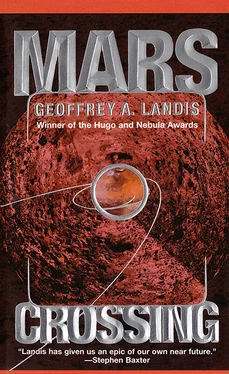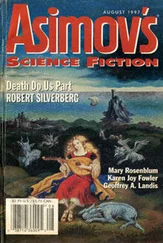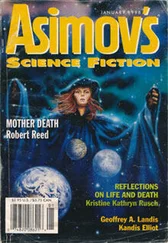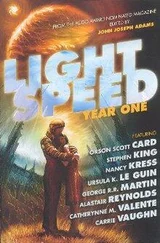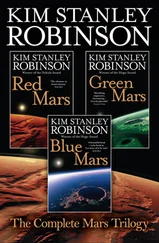By their bold choice of landing site, they had simplified the mission, eliminating the requirement to haul hydrogen from Earth and the need to use cryogenic coolers for the propellant they manufactured. They simplified their mission in another way as well. Instead of having a separate vehicle land first to manufacture the propellant, they used a single landing. One vehicle with a two-man crew would land on Mars, manufacture their return fuel, and take off. They bet the mission on the ability to make fuel, with no mistakes, the first time. There was no margin for error.
They launched in 2020. Two years before the American expedition.
Even if they had wanted to, there was no way to hurry the Agamemnon ; it had to wait for the Ulysses to make its fuel and for the planets to return to the alignment needed for the launch. The American expedition watched, envious and impotent, as two astronauts planted the Brazilian flag on the snows of Mars. They watched, by video broadcast, as the Brazilian astronauts filled their fuel tanks for their return and used hydrogen peroxide-fueled snowmobiles to explore the polar regions surrounding their spacecraft’s landing site.
As the world watched on live television from Mars, the two Brazilian astronauts played in the polar snows, drilled core samples, and analyzed the embedded soil and dust for information about the climate and biology of Mars. The worldwide audience cheered. They had no hint that anything was going wrong.
One moment, João Conselheiro, the expedition leader, said calmly, “Puxa, estou muito cansado.” I am very tired. He sat down on the snow.
The second astronaut walked toward him. “Acho que tem alguma coisa errada com o João.” I think something’s wrong with João. Then, a moment later, he fell over.
Neither astronaut moved again.
After two months—the camera broadcasting all that time—the Martian winter blanketed their bodies with snow.
The Brazilian commander João Conselheiro had left behind a young and beautiful wife who was also a pilot, a geologist, and a mountain climber. Her name was Estrela Carolina Conselheiro.
The way I figure it,” Radkowski had once told Tanisha Jackson, “I’m the one who’s actually black. You’re just another nice white girl from the ’burbs.” Between the two of them it had been a joke, how he had grown up in a ghetto, raised by a welfare mother with a brother in jail and a father he’d never met, while she had been raised in Pennsylvania suburbs, with both parents doctors, and gone to an expensive private school.
Tana never complained, but nevertheless it stung her when people called her white. Just because she hadn’t been raised in a ghetto and didn’t talk like a gangsta, that didn’t mean she wasn’t black. She still had to deal with all of the crap that people brought her because of her skin color.
Nevertheless, she got along fine with Radkowski. She’d even slept with him a few times. Once had been in the space station, but that hardly counted, since sex was one of the very first things that everybody did when they got into space, once they got over throwing up. It was a rite of passage, and Radkowski, who had been a veteran, was a good person to initiate her. But she’d done it a few times afterward, too, and although she was by no means in love with him, it had meant more to her than just a pleasant way to kill an hour or two.
She’d thought about it a few times on the voyage out, but even when they were alone together—something that didn’t happen very often in the crowded ship—he had given no indication of interest. It would be bad for the crew morale if they had paired off, Tana had realized, and Radkowski knew it, and was keeping it cool for the sake of crew unity. Although that didn’t seem to be any barrier to Estrela.
There was, as far as Tana could see, no actual written requirement that a female astronaut from Brazil had to be a sultry spitfire who flirted with every single male she met—but Estrela was, and did.
Tana was compact and muscular and wore her hair in a practical style, barely longer than a crewcut. Estrela, on the other hand, was tall, slender, and curved in all the places that Tana wasn’t. And to top it off, she had kept her thick hair. Tana advised her that it was impractical, possibly even dangerous, for her to wear it long, but Estrela had ignored her, and in freefall, when her hair floated around her face like a dark halo, even Tana had to admit—if only to herself—that it looked glorious.
The rest of the crew—even Trevor—had gone back inside. Only Tana and Estrela stayed on the surface to watch the sunset.
Even in training, back on Earth, they had often watched the sunset together. “When I can, I always watch the sunset,” Estrela had told her. “It is so romantic.” Sometimes Estrela brought her boyfriend of the moment. Sometimes she was alone.
The Brazilian Mars expedition had taken no video of the sunset; at their landing site, the sun had never set. By now she knew it would be unwise to remind Estrela of that. The first international expedition had taken videos of the sunset, plenty of them, and she had seen them, of course, but the real thing was surprisingly different. The colors were subtler. The sky was a luminous hue closer to a golden bronze than the washed-out pink of the videos, and shaded imperceptibly to almost pale blue as she looked toward the sunset, a ball of light hovering above the yellow sun. The sun was smaller than the sunsets she was used to, and in the deep shadows the ridges of Felis Dorsa were a dark brick, almost brown.
They watched the sunset in a companionable silence.
It was cold. Through the day Tana’s suit cooler had been rejecting heat nearly at full capacity, as her body produced more waste heat than she lost by conduction through the well-insulated material. Now, though, in the cool of the Martian evening, even at their landing site near the equator the temperature dropped to forty degrees below zero, and the microcontroller monitoring the suit’s environment was sending electrical currents through thin-film heaters pressed against the thin inner lining of the suit. The soles of her feet, in thermal contact with the cold Martian soil, were cold; so were her hands.
The sun had set. Behind them, the external lights of Don Quijote beckoned. Tana checked the time. “Yikes!” she said. “I think it’s time to come in now.”
In the dark, she couldn’t see Estrela’s face behind her visor, only the reflection of the afterglow. It could have been anybody with her. For a moment Tana allowed herself the indulgence of imagining it was John. She reached out and impulsively touched Estrela’s hand.
She wondered what Estrela was seeing.
8
The Second Expedition to Mars
When the news came that the two astronauts of the Brazilian expedition to Mars had died, John Radkowski should have already been on the way to Mars. He had been picked to be the copilot of the Agamemnon .
Eleven days before launch, Jason, the nine-year-old son of the woman who lived in the duplex next door to Radkowski, had been doing his house chores. Radkowski had a lot of sympathy for Jason; he knew how hard it was to grow up without a father. When Jason went outside to empty the garbage, he had found a skunk in the garbage can. Apparently the skunk was foraging through the garbage, slipped into the can, and had been unable to get out.
The skunk had been sleeping on top of the garbage. Little Jason was old enough to have known that he should leave a wild animal strictly alone—let alone never to mess with a skunk—but the skunk had been so cute, and seemed so harmless, so pettable.
So he petted it.
Читать дальше
